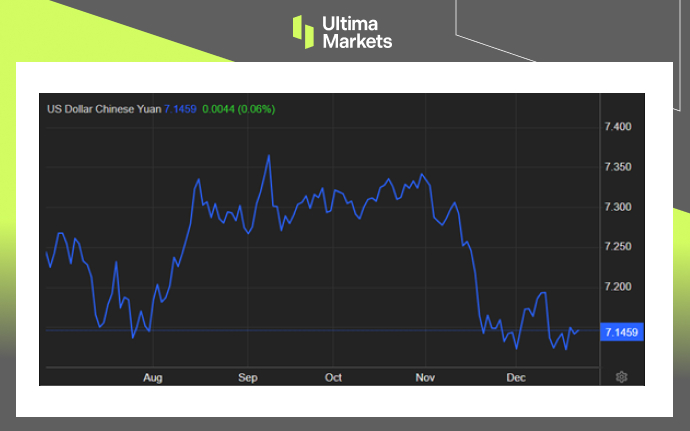Please note that this website is not intended for EU residents. If you are located in the EU and wish to open an account with an EU investment firm and protected by EU laws, you will be redirected to Huaprime EU Ltd, a company licensed and regulated by the Cyprus Securities and Exchange Commission with licence no. 426/23.

The Impact Of PBOC’s Rate Decision On Yuan Depreciation
TOPICSYuan Falters: Chinese Central Bank Unchanged Rates Prompt Currency Retreat
The Chinese yuan faced a setback against the US dollar this week, retreating from its six-month peaks as the People’s Bank of China (PBOC) opted to maintain key interest rates. The offshore yuan, which had surged amid expectations of divergent Chinese and American monetary policies, declined to around 7.13 per dollar.

PBOC’s Monetary Policy and Yuan Movement
Stability Amidst Economic Challenges
Despite mounting calls for accommodative measures in the face of deflationary pressures and sluggish growth, the PBOC held its ground. The one-year and five-year loan prime rates remained at 3.45% and 4.2%, respectively. This decision, aimed at ensuring stability, led to the depreciation of the yuan against other currencies.
Market Speculations on Future Moves
Market sentiment suggests expectations of future rate cuts by the PBOC, potentially in the coming year, as China grapples with economic challenges. Speculations also include the possibility of a reduction in the reserve requirement for banks, injecting liquidity into the financial system. The absence of action by the PBOC this week halted the yuan’s recent gains.
Yuan-Dollar Dynamics
Earlier dynamics, driven by predictions of a Federal Reserve rate cut and sustained low rates by the Bank of Japan, had propelled the yuan’s rise against the dollar. However, with the PBOC maintaining its stance, the differing approaches to interest rates and monetary policy between China and the US are expected to influence the yuan’s trajectory in the coming year.
Currency Outlook and Economic Impact
Assessing Economic Recovery
China’s economic recovery from the extensive COVID-19 lockdowns has encountered challenges, leading to calls for stimulative measures. The PBOC’s decision not to adjust rates this week suggests a cautious approach, considering factors such as deflationary pressures and slowing growth.
Future Yuan Performance
The future performance of the yuan hinges on the evolving economic landscape and the PBOC’s response to ongoing challenges. The currency’s recent depreciation against the dollar, exceeding 8% since its peak in January, underscores the complexities facing China’s currency.
Central Bank Intervention and Market Dynamics
CNBC Reports on State Banks
Recent reports by CNBC highlight Chinese state banks actively selling U.S. dollars to buy yuan. This intervention aims to counteract the yuan’s depreciation and reflects the intricate dance between central bank actions and market forces.
Historical Context: 2015 Devaluation
To understand the current dynamics, it’s valuable to explore the impact of China’s 2015 devaluation on the yuan. Since then, the currency has appreciated 33% against the U.S. dollar, showcasing the fluid nature of currency valuations.
Frequently Asked Questions
Q: What led to the recent depreciation of the yuan?
A: The recent depreciation can be attributed to the People’s Bank of China (PBOC) maintaining key interest rates amidst economic challenges.
Q: Are there expectations of future rate cuts by the PBOC?
A: Market speculations suggest potential rate cuts and a reduction in the reserve requirement for banks in the coming year.
Q: How does the yuan’s performance relate to global interest rate trends?
A: The yuan’s recent rise was influenced by predictions of a Federal Reserve rate cut, emphasizing the impact of global interest rate differentials on currency dynamics.
Bottom Line
In conclusion, the recent depreciation of the Chinese yuan against the US dollar reflects the delicate balance the PBOC is navigating in response to economic challenges.
As market speculations and global interest rate trends continue to shape currency dynamics, the yuan’s future performance remains a dynamic area to watch.
لماذا تختار تداول المعادن والسلع مع Ultima Markets؟
توفر Ultima Markets البيئة التنافسية الأفضل من حيث التكلفة والتبادل للسلع السائدة في جميع أنحاء العالم.
ابدأ التداولمراقبة فعالة للسوق أثناء تنقلك
الأسواق عرضة للتغيرات في العرض والطلب
جذابة للمستثمرين المهتمين فقط بالمضاربة على الأسعار
سيولة عميقة ومتنوعة بدون رسوم مخفية
لا يوجد مكتب تداول ولا إعادة تسعير
تنفيذ سريع عبر خادم Equinix NY4















